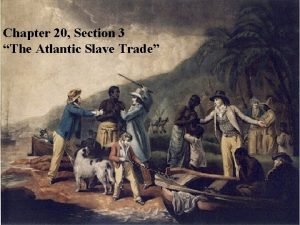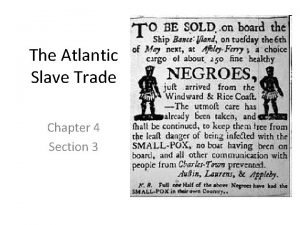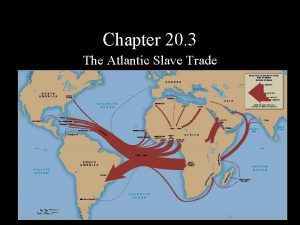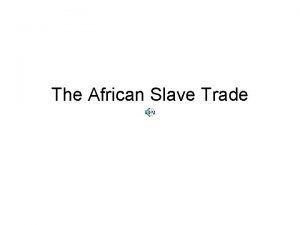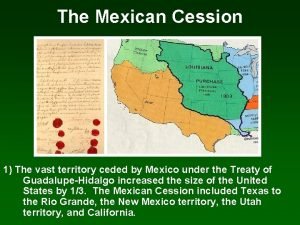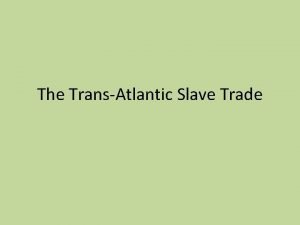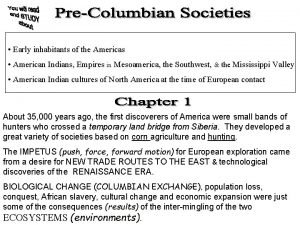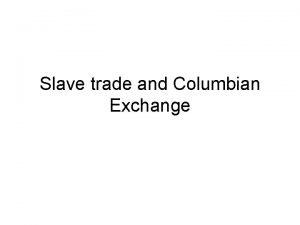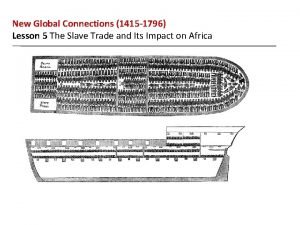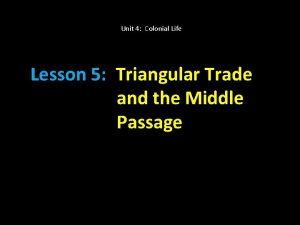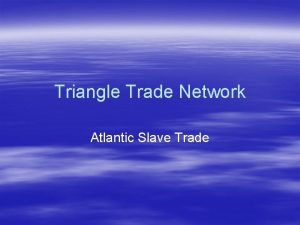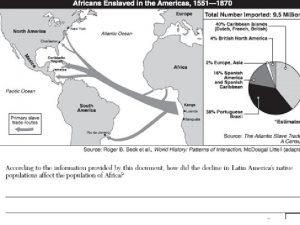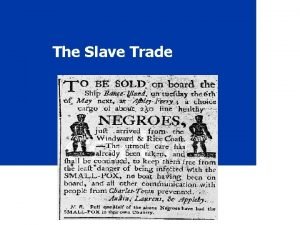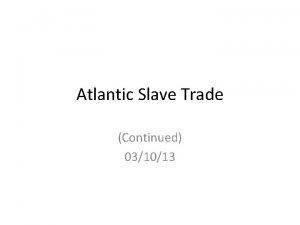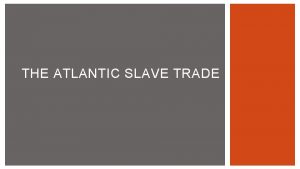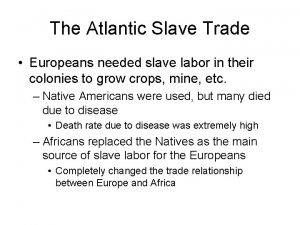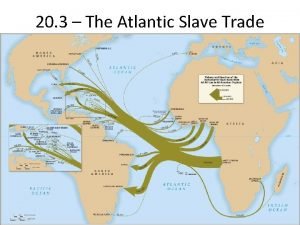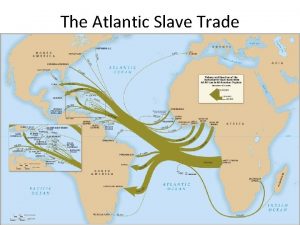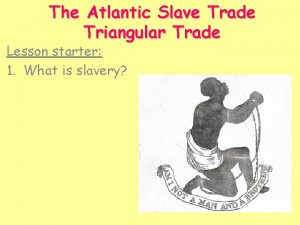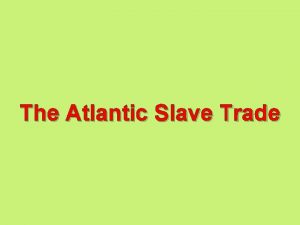Chapter 20 3 The Atlantic Slave Trade Causes














- Slides: 14

Chapter 20. 3 The Atlantic Slave Trade

Causes • The Americas – Need for cheap labor source: Sugar and Tobacco – Native Americans (original labor source) die from European diseases • Why didn’t Africans die? – Profitability of industries (sugar, tobacco, mining, coffee, cotton) is a “pull” factor • Africa – Drought and famine in Africa results in selling of children and adults into slavery – Warfare and enslavement: response to European demand – African merchants and rulers willing role to sell its people – Supply and demand (for products and labor)

Slavery in Africa • Slavery not a new concept • 7 th century (600 s) spread of Islam increases slave trade – Across the Sahara, the Red Sea and the Indian Ocean • Justification for – Muslim belief non-Muslim prisoners can be bought and sold • b/t 650 -1600 17 million Africans transported throughout Muslim land in North Africa

Slavery in Africa Cont… • African and Muslim Societies allow – Slaves’ rights and upward mobility – Muslim slaves have positions of power and serve in military – African slaves may marry into family of slave owner

Africa’s Role • Euro traders wait at ports • Local rulers and merchants capture Africans to sell • Exchange humans for gold, guns, and goods • Profits lure more rulers

Contributors to Slave Trade • Portugal and Spain lead way • Colonization of Americas kills off native population • African’s Advantage over Native Americans: – Exposure to Euro’s diseases and animals – Experienced farmers – Escape less likely – Skin color (you are a slave!)

Contributors by Volume • England: – From 1690 to abolishment leading carrier – 1. 7 million to colonies in West Indies – 400, 000 to North American colonies • Portugal: – 17 th century more than 40% to Brazil • French, Dutch, Spanish • Danish least amount

Mapping the Contributors

Mapping the Volume

Triangular Trade • Triangular Trade crisscrossed northern and southern colonies, West Indies, England, Europe, and Africa • The first stage : – Take manufactured goods from Europe to Africa: cloth, spirit, tobacco, beads, shells, metal goods, and guns. – Guns were used to help expand empires and obtain more slaves. Goods were exchanged for African slaves. • The second stage of the – The Middle Passage involved shipping the slaves to the Americas. • The third stage – Involved returning to Europe with the products of the slavelabor: cotton, sugar, tobacco, molasses and rum.

Mapping the Trade

The Middle Passage • • • Humans are “cargo” on a slave ship Theory: majority of deaths occurred during the middle passage – – Result of malnutrition and disease Survival Rate for the Middle Passage – Estimated death rate of around 13% – Lower than the mortality rate for seamen, officers and passengers on the same voyages

Population Shift • Result of the slave trade on colony populations: – Five times as many Africans arrived in the Americas than Europeans. • David Eltis 1893: – By 1820: 8. 4 million African immigrants to Americas – 2. 4 million Europeans – Euro population however exceeds African’s by 11 million – Sex ratios: more men then women – Survival and reproduction of Africans dramatically lower – Fertility rates low/mortality rates high • Location, location – Geography: most slaves settled in low-lying tropical areas – General mortality rate in areas higher than temperate regions

Culture Survives • Cultural heritage survives as way of coping • Forms of Resistance – Slow work – Escaping – Revolts: Spanish, Brazilian, North American, and West Indies colonies • Stone Rebellion – South Carolina 1739
 Chapter 20 section 3 the atlantic slave trade
Chapter 20 section 3 the atlantic slave trade Chapter 4 section 3 the atlantic slave trade
Chapter 4 section 3 the atlantic slave trade The atlantic slave trade chapter 20 section 3
The atlantic slave trade chapter 20 section 3 Atlantic slave trade
Atlantic slave trade Ted talk slave trade
Ted talk slave trade The age of exploration outcome the atlantic slave trade
The age of exploration outcome the atlantic slave trade The age of exploration outcome the atlantic slave trade
The age of exploration outcome the atlantic slave trade Washington dc slave trade
Washington dc slave trade Transatlantic slave trade pictures
Transatlantic slave trade pictures Effects of the slave trade on africa
Effects of the slave trade on africa Triangular trade apush
Triangular trade apush The transatlantic slave trade
The transatlantic slave trade Lesson 5 the slave trade and its impact on africa
Lesson 5 the slave trade and its impact on africa Slave trade primary sources
Slave trade primary sources Destination america
Destination america
